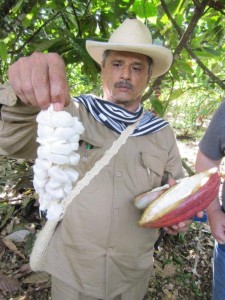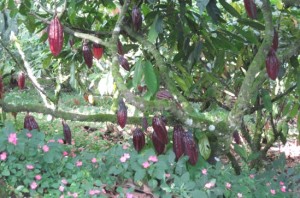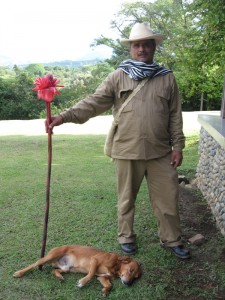On the Farm with Colombia’s Cordillera Chocolate Growers
Last fall I had the pleasure of traveling to beautiful Colombia to visit the birthplace of the delicious Fair Trade Certified™ Cordillera chocolate with which Bon Appétit Management Company chefs bake. Now that I’ve gone over the basics in my first post, I’ll discuss where the path to making a delicious chocolate bar starts: the farm. To read the socially responsible aspect to Fair Trade chocolate production, check out my third post.
Cacao beans grow in multicolored, football-shaped pods, and if you can open one up without slicing your hand open with the machete, you’re rewarded with beans covered in a tasty white pulp. The beans and pulp are then thrown in a large wooden box to ferment, sun-dried on the rooftop, and transported to the closest co-op while the pods are left on the ground to rot. The rotting unfortunately releases huge amounts of C02 into the atmosphere and nitrogen into the surrounding soil — the detrimental effects of which can be seen on the trees surrounding the pod pile, which oftentimes can’t produce their own pods.
The Compañía Nacional de Chocolates (CNC) has lots of great programs to help their farmers, but the one that really impressed me was its education program. The company holds classes for farmers at demonstration farms — the farm the company has identified as having the best practices in the area. That way, cacao farmers from the region can gather at these exemplary farms and learn different ways of improving their own farm while seeing these solutions implemented firsthand. Using this method of showing their farmers what to do and why it’s beneficial to do it, the CNC hopes to convince all of its farmers to compost their discarded pods in the next three years, which will significantly reduce their carbon footprint.
One of these practices that the farmers were most excited to show me was grafting. This is when a farmer cuts off the branch of a cacao tree, then attaches a piece of a different species of tree over the wound. Over time, a new branch will grow, producing a second strain of cacao, meaning that more than one type of cacao pod can grow on the same tree! This allows farmers to transition to more productive strains of cacao, especially when the original tree is past its peak of productivity. Eventually, the old branches will be cut to channel all of the resources from the roots into the new branch.
Whether it’s from years of experience or the great educational programs the CNC organizes, it was evident to me that cacao farmers really understand their land. Farmers know that maintaining the biodiversity of their farm is crucial for the cacao’s success, so they intentionally place certain types of plants there to provide a suitable habitat for the cacao. I saw lots of citrus trees to provide nutrients to the soil, large plantain and cedar trees for shade, while an understory of delicate flowers effortlessly blanketed the ground.
One of the things I loved most about visiting these cacao farms was all of the animals. There were chickens wandering around, feasting on bugs and fertilizing the ground as they went; turkeys picking through the compost pile of cow manure and wood shavings; even horses and donkeys to help with transport. And no cacao farm would be complete without a small army of dogs to scare off the cacao’s biggest predator: the squirrel.
I was admittedly disappointed that it wasn’t something more exotic like a tapir or a spider monkey, but those little bushy-tailed buggers can do some damage — especially when a well-meaning visitor distracts the guards with petting!


